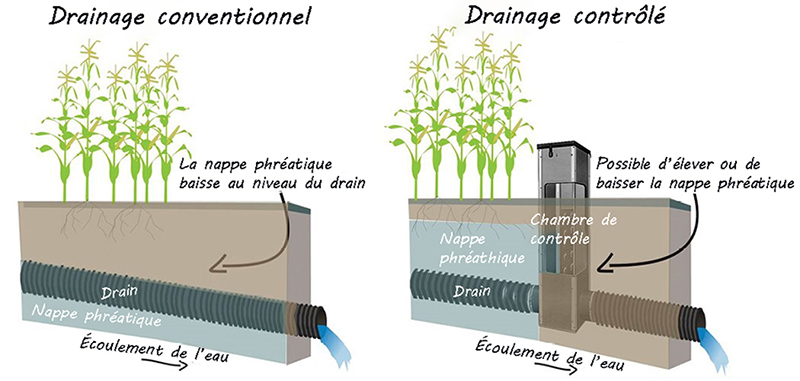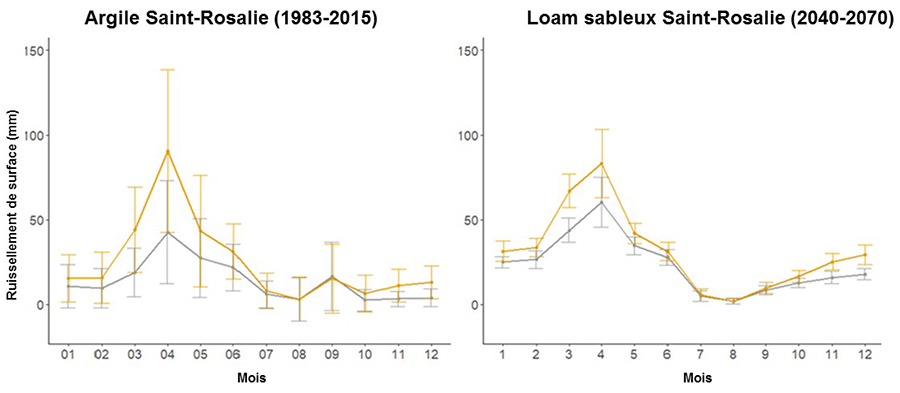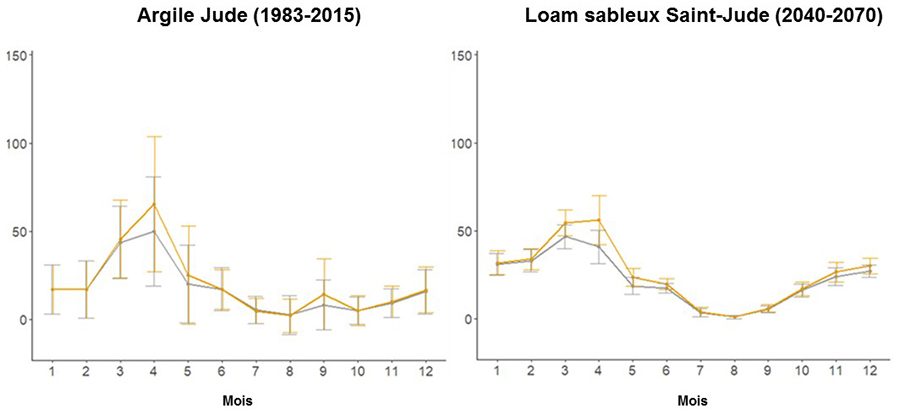Managing Subsurface Drainage Water to Optimize Crop Productivity, Nutrient Use and Water Availability in Contemporary and Future Climat
The results of this study provided producers and agricultural advisors with information about the benefits and limitations of controlled drainage as an adaptation measure against expected climate change.
Project details
Principal(s) investigator(s)


Context
A dominant portion of the most productive farmland in Ontario and Quebec benefits from artificial drainage. Historically, drainage systems have been installed to clear excess water in spring, and promote early seeding and profitability of crops. The benefits of artificial subsurface drainage are obvious.
However, drainage waters have been shown to be a significant pathway for nutrients (N and P), where up to 80% of total surface water yields originate from subsurface drains. Moreover, climate change studies indicate that water stresses to crop productivity will increase in future climate, together with a longer growing season, related to an earlier snowmelt. Despite numerous benefits, agricultural producers have been slow to adopt controlled drainage systems.
Objective(s)
-
To assess the agronomic and environmental feasibility and benefits of controlled drainage in contemporary and future climates from both a quantitative perspective, in meeting crop water requirements and community needs, as well as from a qualitative perspective, in assessing effects on nitrogen and phosphorus losses in surface waters.
Methodology
On the scale of fields and a micro watershed:
-
Acquisition of hydrometric data, water quality and crop results ; Production of a complete water balance from hydrolometric observations ; Estimation of the effects of controlled drainage on water balance, water paths, crop growth, and sediment, phosphorus and nitrogen exports to drains.
For two agricultural watersheds (David River in Quebec and Medway Creek in Ontario):
-
Calibration and validation of the SWAT-MAC hydrological model (IRDA, McGill) on the basis of hydrometric observations ;
-
Coupling of hydrological models with future climate scenarios and controlled drainage scenarios (absent vs. present) to assess the effects on water balance, flow distribution and water quality
Results

Monitoring of water table heights in two fields in Québec, as well as their flows and fluxes of sediment, nitrogen and phosphorus to the drain, showed marginal effectiveness of controlled drainage in retaining water in the soil profile due to the early lowering of the water table in the spring.
The presence of deep watercourses in the study area would explain the early water table drawdown below drain levels. Drains are a significant pathway for phosphorus transfer (0.78-0.87 kg P/ha-yr), which occurs mainly during peak flow periods when the snow cover melts. Deficient surface runoff (control field) exacerbated these losses by encouraging preferential flow to the drains. The quality of surface drainage is therefore a prerequisite for the subsurface drainage management scenarios.
Two studies
With respect to the effects of controlled drainage on water quality, the benefits were found to be site specific.
In the Ontario study conducted on a sloping clay loam, activation of controlled drainage exacerbated the emission of surface runoff and led to the deterioration of surface water quality.
In the Québec study, it is estimated that controlled drainage can reduce the preferential migration of phosphorus to the drain via soil macropores in flay clay fields, provided it does not lead to increased surface runoff.
Regarding the feasibility of controlled drainage in future climates, despite early spring warming, water retention by closing the tile collectors remains limited due to the anticipated increase in winter and spring precipitations under future climates, which increases the risk of surface runoff. However, models predict that the feasibility of limiting water table drawdown, without increasing runoff, is dependent on soil type (Figure).


Figure: Predicted monthly surface runoff (mm) in current and future climate, for two contrasting soil types under grain corn production, with drainage (grey) and without drainage (orange) souterrain (Rivière David watershed, Montérégie).
Although it is possible to use controlled drainage only in the summer season, when the risk of surface runoff is low, this period is not conducive to nutrient losses from drains. Controlled drainage would therefore have only a marginal effect on these loads in the summer. A practical implication of these observations is that effective retention of the water table during the growing season would also be achieved through retention structures at the watercourse level. The study also showed that controlled drainage is unlikely to have a tangible effect on water quality in future climates if it is not used earlier in the season than it is now. The use of controlled drainage outside the growing season is problematic, however, as it can increase surface runoff and degrade water quality.
These observations apply to manual closure of drains. In the context of “precision water management”, where drains would be opened or closed at varying water table control heights depending on the season, controlled drainage may offer greater potential to alleviate crop water stress without increasing surface runoff.
Benefits for adaptation
Benefits for adaptation
The results of this study provided producers and agricultural advisors with information about the benefits and limitations of controlled drainage as an adaptation measure against expected climate change.
Scientific publications
Funding


La contribution d’Ouranos dans ce projet est en nature.
Other participants
-
Upper Thames Conservation Authority
-
Club Lavallière
-
Club agroenvironnemental Pro-Conseil
-
OMAFRA